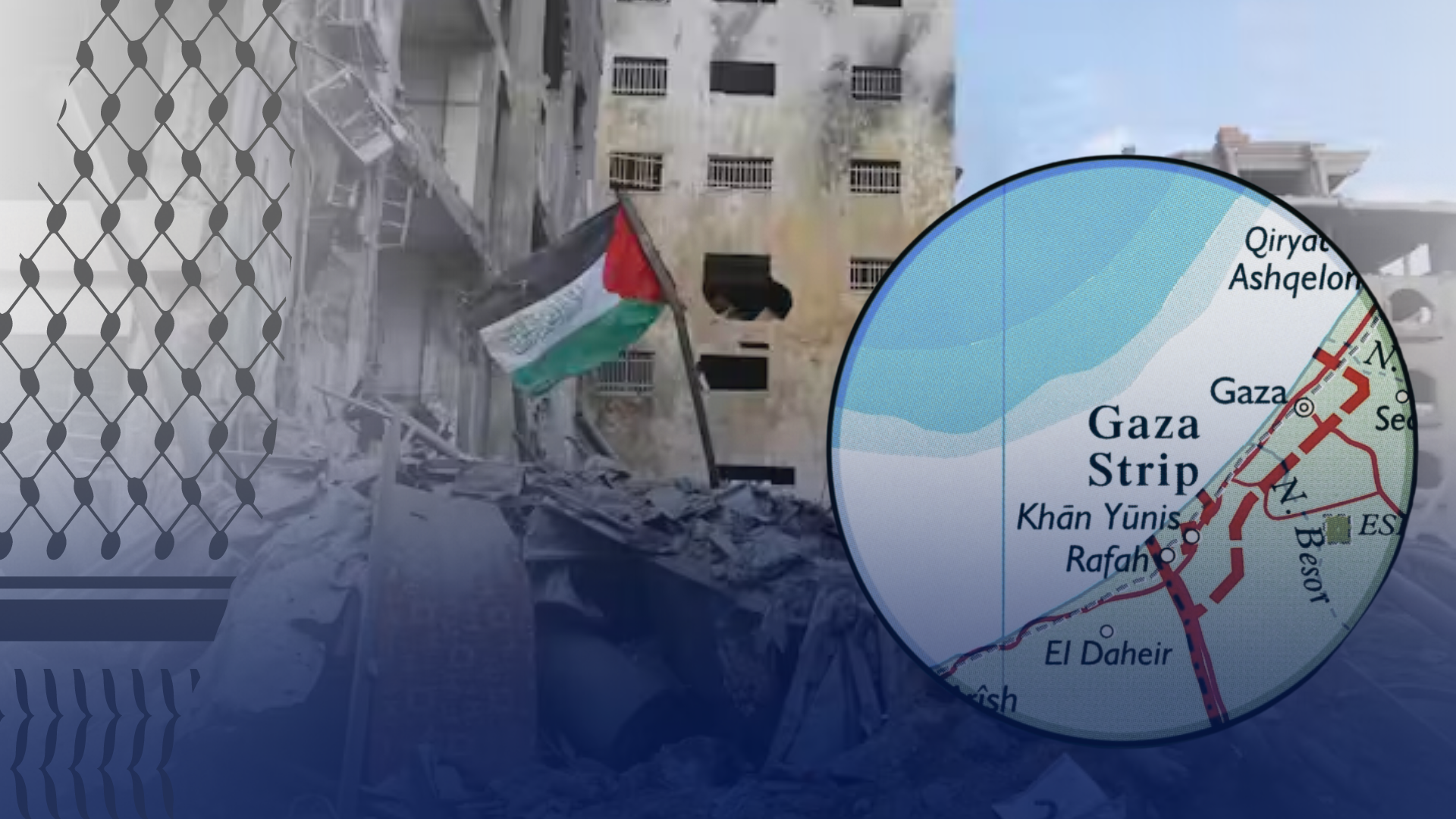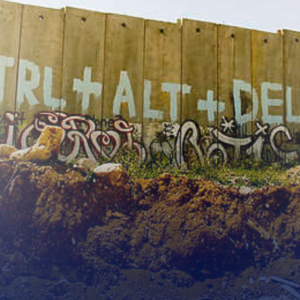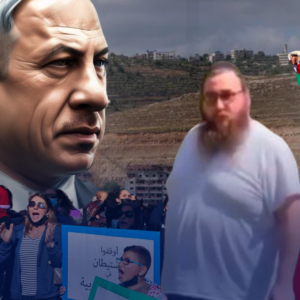All About Palestine VI: Occupied Palestine 2007-2022: The Gaza Strip

All About Palestine VI: Occupied Palestine 2007-2022: The Gaza Strip
Palestine. What was once a thriving, culturally, and religiously diverse land, now lies under the military occupation of a racist, colonial regime. In the early 1900’s, ‘Imperialism’ and ‘Zionism’ merged together in perhaps the greatest conspiracy in human history: to uproot a nation and establish a military outpost in the form of a settler-colony on the shores of West Asia, to serve the British Empire’s interests in the region.

All About Palestine VI: Occupied Palestine 2007-2022: The Gaza Strip
Palestine. What was once a thriving, culturally, and religiously diverse land, now lies under the military occupation of a racist, colonial regime. In the early 1900’s, ‘Imperialism’ and ‘Zionism’ merged together in perhaps the greatest conspiracy in human history: to uproot a nation and establish a military outpost in the form of a settler-colony on the shores of West Asia, to serve the British Empire’s interests in the region.
Written by: Nadia Hojaij and Yahia Hassani | Copy Editors: Zainabrights | Design: Fatima El-Zein
* The current report was completed at the outset of Israel's 2023-2024 War on Gaza, focusing on the history up until that point. The ongoing war will be written about extensively in a separate report by TMJ News.

Introduction to Apartheid
Since the establishment of the Israeli entity in 1948, successive governments have created and maintained a system of apartheid laws, policies, and practices designed to oppress Palestinians and privilege Jewish Israelis. Palestinians have been fragmented geographically and politically, and experience different levels of discrimination based on their status and location.
Israel has divided Palestinians into different groups for purposes of control, and to varying degrees. They are classified into five statuses or categories of rights, all of which are inferior to Jewish Israeli rights, in the following order of most rights to least:
1. Palestinian citizens of Israel: colonized since 1948, treated as second class with over 65 discriminatory laws.
2. Palestinians in East Jerusalem: annexed since 1967, granted primary residence status but risk expulsion.
3. Palestinians in the West Bank: occupied since 1967, live under military rule.
Palestinians in Gaza: besieged since 2007, living under a land, air, and sea blockade.
4. Palestinian refugees: exiled since 1948, 6 million refugees living in camps with no right to return.
Maintaining a Jewish demographic majority is crucial for Israel’s character as a “Jewish State,” therefore Palestinians are prevented from upgrading in status, but are free to downgrade.
Israel manages the occupied territories of the West Bank, East Jerusalem, and Gaza as three separate, unrelated areas.
In the early 90’s, Israel began to enforce a permit system for Palestinians to travel between these areas, though it rarely allows such permits, especially from Gaza. Prior to the permit system, Palestinians traveled almost freely throughout the occupied territories and Israel, for work, trade, education, medical care and family ties.
UN experts, leading rights groups, and legal experts consider Israel an apartheid state due to its systemic oppression, institutional discrimination, persecution, and military occupation and aggressions against Palestinians. The UN Special Rapporteur for human rights in the occupied territory, Michael Lynk, reported Israel practices apartheid, stating “a political regime which so intentionally and clearly prioritizes fundamental political, legal and social rights to one group over another within the same geographic unit on the basis of one’s racial-national-ethnic identity satisfies the international legal definition of apartheid.” Former UN Secretary General Ban Ki-Moon has also reported that Israel practices apartheid.
Israeli human rights group B’Tselem refers to Israel as an apartheid regime. Human Rights Watch concluded the Israeli government’s intent on maintaining Jewish Israeli dominance over Palestinians through systemic oppression and inhumane acts amounting to apartheid. Amnesty International published a 280 page investigative report titled “Israel’s apartheid against Palestinians: Cruel System of domination and crime against humanity” which analyzed Israel’s intent to create and maintain a system of oppression and domination over Palestinians through territorial fragmentation, segregation and control, dispossession of land and property, and denial of economic and social rights.
Amnesty’s research demonstrates Israel’s treatment of Palestinians as an inferior racial group across all areas in pursuit of the same objective: to privilege Jewish Israelis in distribution of land and resources, and to minimize the Palestinian presence and access to land. Amnesty has also created a free 90-minute course called “Deconstructing Israel’s Apartheid Against Palestinians.”
Former head of Israel’s Mossad intelligence agency Tamir Pardo stated
“There is an apartheid state here. In a territory where two people are judged under two legal systems, that is an apartheid state.”
Former Israeli Attorney General Michael Ben-Yair has also reported that Israel practices apartheid.
The following four parts of this report will explain the five categories of discrimination against Palestinians based on their status and location, beginning with the Gaza Strip.
The Gaza Strip
In 1948, Zionist militias colonized 78% of Palestine, establishing the State of Israel. In 1967, Israeli forces occupied the remaining 22%, seizing the West Bank and Gaza. In 1987, decades of Palestinian discontent under Israeli occupation erupted into the First Intifada. The popular uprising consisted mostly of mass demonstrations, protests, and general strikes, before Israeli forces adopted the so-called “iron fist” policy of violent repression, using live ammunition against unarmed protestors and implementing the “bones breaking” protocol against rock-throwers. This led to the emergence of organized armed resistance groups, most notably Hamas, who engaged in armed struggle against Israeli military aggression.

In 1993, the Oslo Accords culminated in PLO recognition of Israel over the usurped lands of 1948 in exchange for Israeli withdrawal from the occupied lands of 1967. The land-for-peace agreements called for a “two-state solution” formally ending the popular uprising. In 2000, after Israel’s noncompliance to withdraw, continued settlement-expansion, and no independent state granted, Palestinian frustration erupted into the Second Intifada. In 2005, the PLO’s Fatah party reopened diplomacy with Israel to continue futile negotiations. However, Palestinian resistance groups, namely Hamas and Palestinian Islamic Jihad (PIJ), continued their armed struggle against the Israeli occupation after successfully liberating Gaza from Israeli forces and settlers. In 2006, Palestinians held general elections, resulting in a surprise victory for Hamas. After a power struggle with rival Fatah, Hamas assumed political control of Gaza while Fatah resumed limited self-governance of the West Bank.
The Gaza strip is one of the most densely populated areas in the world with a current population of 2.3 million people in an area of about 140 square miles, about the same size as Detroit, Michigan. The vast majority of Palestinians in Gaza, nearly 1.5 million, are officially registered refugees who have been forcibly displaced from their homes and ethnically cleansed since the Nakba.
Hamas
Hamas, also meaning “Zeal,” is an acronym for Harakat al-Muqawama al-Islamiya, meaning Islamic Resistance Movement in Arabic. It was founded during the First Intifada by scholar and activist Sheikh Ahmed Yasin, the group’s spiritual leader and a quadriplegic, who was later assassinated by Israeli airstrikes during the Second Intifada. According to its 2017 Charter, Hamas is a Palestinian Islamic national liberation and resistance movement with its goal to liberate Palestine and confront the Zionist project. Its frame of reference is Islam, which determines its principles, objectives and means. Hamas considers the establishment of an independent Palestinian state along the pre-1967 lines (meaning in the West Bank and Gaza) with Jerusalem as its capital. However, it does not recognize the legitimacy of the Zionist entity in the remainder of Palestine, calling for its complete liberation and the refugees right of return. The organization has political, social, and military branches, with its armed wing known as the Izz al-Din Al-Qassam Brigades. Hamas runs a wide network of charitable, social, and welfare associations. Its leadership is located both inside and outside of Palestine, consisting of an Islamic council and political bureau, currently led by Chairman Ismael Haniyeh.
Resistance
Although Palestinian resistance groups were able to expel Israeli occupation forces and settlers from Gaza in 2005, Israel remained in control of Gaza’s border, coastline, and airspace. Therefore, according to international law, Israel retained its identity as an occupying power. Thus, despite Palestinians gaining nominal control within Gaza, it remained under overall Israeli military occupation, continuing to suffer as a result. The people of Gaza remained confined within an “Iron Wall,” made of concrete and electric fences equipped with cameras, sensors, radars, and remote control weapons systems. The UN, US, international community and human rights organizations continued to consider Gaza as illegally occupied.

After the Second Intifada, and since 1948, Israel continued to expand its settler-colonial project and ethnic cleansing of Palestinian territories. In response, Palestinian resistance groups in Gaza continued to engage in their internationally recognized right to armed struggle against the illegal Israeli military occupation and blockade, and to force Israel to comply with international law.
According to UN Resolution 37/43, the UN reaffirms the legitimacy of the Palestinian people’s struggle for independence, territorial integrity, national unity, liberation from colonial domination, apartheid and foreign occupation by all available means, including armed struggle.
In June 2006, Palestinian resistance groups in Gaza captured an Israeli soldier, Gilad Shalit, in a cross-border raid, aiming to exchange him for Palestinian women and children held captive in Israeli jails. Israel launched its first military assault on Gaza since its withdrawal, targeting civilian infrastructure, roads, bridges, and Gaza’s only power plant. In November, a ceasefire was called and Israel withdrew with no deal reached. (Gilad was later exchanged for more than 1,000 Palestinian prisoners in 2011 after five years of negotiations). Throughout the aggression, 416 Palestinians were killed, including at least 58 children, with approximately 1000 injured, whom Israel claimed were being used as “human shields.” UN humanitarian officials condemned Israel’s disproportionate use of force and blatant acts of war crimes. In 2007, Israel imposed a land, air, and sea blockade on the Gaza strip. Thus began a new era of sporadic Israeli military onslaughts on Gaza with continuous Palestinian resistance against the siege.
Israeli Blockade on Gaza
In the 90’s, Israel began isolating Gaza from the West Bank and the rest of the world by putting restrictions on the movement of people and goods. Israel also banned Gazans from working inside Israel, affecting the livelihoods of tens of thousands. This caused a deep recession in Gaza and caused a sharp decline in living standards. In 2007, under the illegal blockade, Israel significantly intensified already existing restrictions on external travel, imports, and exports. Israel monitors and controls everything that enters and exits Gaza according to its own interests, using three main crossings, including the Rafah crossing in conjunction with Egypt.
The blockade is a form of economic warfare to collectively punish the entire population of Gaza for democratically electing the path of resistance against the Israeli occupation and refusing to normalize relations with the Zionist entity. The illegal blockade violates Article 33 of the Fourth Geneva Convention, which prohibits collective punishments that prevent a broad range of human rights. The UN Secretary-General has found that the Israeli blockade contravenes international humanitarian law as it targets and imposes hardship on the civilian population, effectively penalizing them for acts they have not committed. Along with sporadic Israeli military aggressions, the inhumane blockade has devastated nearly all aspects of Gaza’s society, economy, and infrastructure, leading to a dire humanitarian crisis with most of the population fully dependent on international aid. According to Israeli Human Rights group B’Tselem, the Gaza Strip is the scene of a humanitarian disaster that has nothing to do with natural causes, but is entirely man-made as a direct result of official Israeli policy.
Israel limits Gaza’s access to clean water, food, medicine, fuel and electricity, causing disastrous shortages which impact nearly all aspects of daily life. Gazans have been restricted from their main urban center and religious site, Jerusalem, which hosts specialized hospitals, consulates, banks, and other vital services. In 2008, Israel made precise calculations on the minimal caloric intake needed for Gaza to avoid malnutrition, which Israeli advisor to PM Barak explained was meant “to put the Palestinians on a diet, but not to make them die of hunger.” Israel also continuously reduces the fishing range allowed in Gaza. In 2010, a Turkish “Gaza Freedom Flotilla,” consisting of six ships and hundreds of activists from many countries who were delivering 10,000 tonnes of aid to Gaza, was attacked by the Israeli navy, causing many casualties and sparking global outrage.
Data regarding the severity of the humanitarian crisis in Gaza has fluctuated over the years. However, the following statistics are based on 2022 UN reports: 65% of the population were food insecure and dependent on international assistance, 65% were living in poverty, and 46% were unemployed. There were only 11 hours of electricity available each day, and 78% of the water piped into Gaza was deemed unfit for human consumption. For imports, the average monthly volume of incoming goods was 30% less than the monthly average pre-blockade, a substantial decrease considering the population has doubled since. For exports, which were nearly prohibited during the first seven years, the annual volume of outgoing goods was 35% less than in 2005, also a significant decrease considering the population growth. People movement exiting Gaza was 93% less than in 2000. Israel only approved 64% of patient requests to leave Gaza for specialized treatment in the West Bank, leading to many patients deaths as a result. Fishing was limited to only 50% of the 20 nautical miles stipulated in Oslo, which in years passed had reached lows of 3 miles.
Multiple human rights organizations, including Amnesty International, Human Rights Watch, and UN experts, have referred to Gaza as an “open air prison.” Many journalists, activists, and academics have referred to Gaza as a “concentration camp”, including Jewish American professors Norman Finkelstein and Noam Chomsky. In 2018, the UN declared Gaza to be “unlivable.”
Israeli Wars on Gaza
Over the years, the Israeli entity launched multiple military aggressions on the besieged enclave, further exacerbating the already dire humanitarian crisis. The ferocity of such attacks were unprecedented in the history of the decades long conflict, which along with the blockade, devastated nearly all aspects of Gazan society, economy, and infrastructure. As a result, Palestinian resistance groups in Gaza continued to engage in their internationally recognized right to armed struggle against illegal Israeli occupation, blockade, and aggressions.
In 2008, Israel launched “Operation Cast Lead,” a twenty-two day assault that killed 1,419 Palestinians and destroyed over 3,500 homes. In 2012, Israel launched “Operation Pillar of Defense,” an eight day attack killing 158 Palestinians and destroying 2,000 homes. In 2014, Israel launched “Operation Protective Edge,” a fifty day onslaught killing more than 2,100 Palestinians, wounding over 11,000, and destroying over 18,000 homes. In 2021, Israel launched an 11 day military aggression on Gaza, killing 232 Palestinians.
Less than 105 Israelis were killed in all four of these wars combined, as Palestinian resistance groups mainly launched un-guided rockets into the colonized territory, with many intercepted by Israel's “Iron Dome.”
Throughout these onslaughts, which Israeli officials often referred to as “mowing the lawn,” Israeli occupation forces indiscriminately bombed residential buildings, commercial towers, schools, mosques, power plants, and hospitals. The damage and destruction had been, up until then, unparalleled in the history of Israeli aggressions on Palestine. Mainstream and social media continued to record Israel’s aerial bombardments into densely populated areas, depicting the horrors Palestinians faced. Gruesome footage of high-rise buildings leveled, neighborhoods reduced to ruins, and corpses lying among the rubble became commonly displayed before the world.
The Israeli entity continuously sparked global outrage and widespread condemnation by the UN, international community, and human rights organizations for its atrocities, war crimes, and disproportionate use of force. In 2020, a health study concluded that more than 53% of children in Gaza suffer from PTSD. In 2021, the UN secretary-general described conditions for children in Gaza as “hell on earth.” Reconstruction in Gaza continued to be severely hindered due to limitations in building material needed, caused by the Israeli blockade.
Great March of Return
In March 2018, thousands of Palestinians in Gaza began participating in weekly demonstrations known as “The Great March of Return.” They were held near the perimeter fence between Gaza and Israel, calling for an end to the illegal Israeli blockade and for the Palestinian refugees’ right to return.

The demonstrations culminated on the eve of the 70th anniversary of the Nakba and received an outpour of global support. Protestors exercised their freedom to express and demonstrate under international law, demanding a right to return back to their towns and villages in what is now Israel. Israeli forces deployed tanks, military vehicles, and snipers behind the perimeter fence.
While the vast majority of protests were peaceful, the Israeli use of tear gas invoked stone throwing, tire burning, and occasional molotov cocktails towards the fence. As the weeks went by, Israeli forces began firing rubber bullets, and eventually, live ammunition on unarmed protestors, causing massive casualties.

Israeli snipers did not differentiate between men, women, children, and clearly marked paramedics and journalists.

Razan al-Najjar, a 21-year-old Palestinian paramedic, was shot in the chest by an Israeli sniper and killed instantly while providing first aid to injured protesters. Israeli human rights group B’tselem concluded Israeli snipers deliberately shot Razan after Israel claimed it was accidental.
Yousef al-Kronz, a 20-year-old journalist, was also shot by an Israeli sniper while covering the demonstrations, requiring his leg to be amputated. Israel’s “shoot to maim” policy created a generation of Gazans on crutches, as a UN inquiry found over 80% of the 6,106 protesters wounded in the first nine months were shot in the lower limbs. The head of Doctors Without Borders agreed, stating “This is obvious. When you have almost 90 percent of the people injured in the lower limb, it means that there is a policy to target the lower limbs.”
Israel received widespread condemnation as mainstream media and social media footage continuously captured its excessive use of force, unlawful killings, and blatant acts of war crimes. In total, 214 Palestinians were killed, including 46 children. More than 36,100 were injured, including nearly 8,800 children, resulting in 156 amputees, with 1 Israeli soldier killed.
The protests were temporarily suspended in December 2019, because after nearly two years of non-violent demonstrations and immense sacrifice, they proved ineffective. According to Amnesty International, military experts and forensic pathologists determined Israeli forces used high velocity military weapons designed to cause maximum harm to unarmed protestors who did not pose an imminent threat to them.
The UN commision of inquiry determined countless violations of international human rights and humanitarian laws, with the use of live ammunition to have been illegal, and demanding accountability. The Israeli government rejected the findings as biased, but investigated 226 cases nonetheless. As of April 2020, Israel prosecuted only one soldier for “unauthorized shooting” who was sentenced to one month in prison. Ahmed Abu Artima, an activist who inspired and organized the march, would later be targeted in an Israeli airstrike during the 2023 Israeli War on Gaza, seriously injuring him and killing five members of his family.
The piece you just read is a part of a larger report on Palestine. Each day we will delve into a different aspect.
* The 2023-2024 Israeli war on Gaza will be written about extensively in a separate report by TMJ News.
SOURCES
- What Price Israel, Alfred Lilienthal, Pages 148-150
If you value our journalism…
TMJ News is committed to remaining an independent, reader-funded news platform. A small donation from our valuable readers like you keeps us running so that we can keep our reporting open to all! We’ve launched a fundraising campaign to raise the $10,000 we need to meet our publishing costs this year, and it’d mean the world to us if you’d make a monthly or one-time donation to help. If you value what we publish and agree that our world needs alternative voices like ours in the media, please give what you can today.



